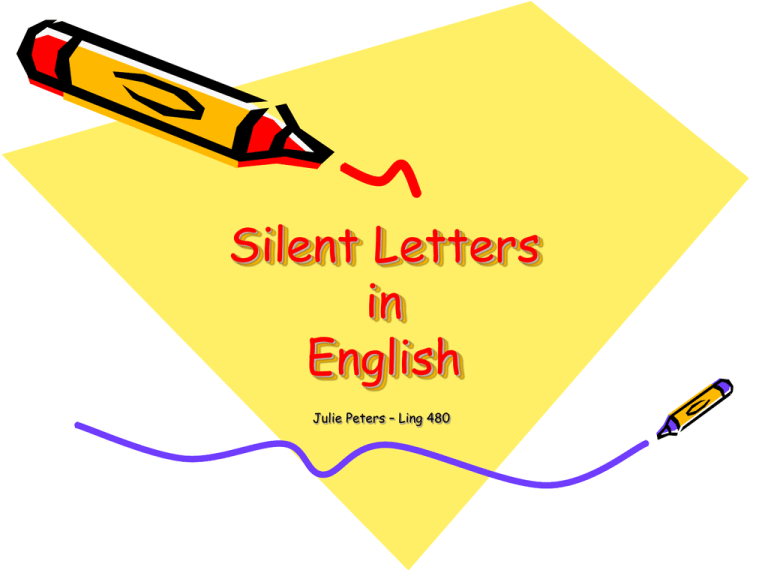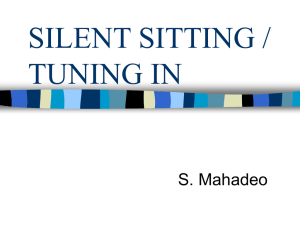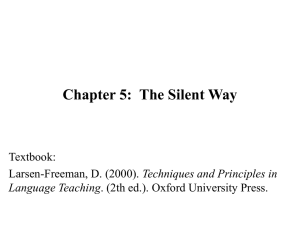Silent Letters in English
advertisement

Silent Letters in English Julie Peters – Ling 480 What are silent letters? Silent letters are letters that appear in the spelling of words, but don’t make a sound. So how many English words have silent letters? “According to Kent Jones, Education Committee, Esperanto Society of Chicago, ‘More than 60% of (English) words have silent letters.’” British Council (n.d.) What caused English to have so many silent letters? • Historical change • Letters added to make the spelling look Latin or French • Borrowed words from other languages • Sound combinations too difficult to say Why should it matter to me as a teacher? • The silent letters can be confusing to many learners, whether they speak English as their first or second language. • The confusion can result in delays with reading, writing, as well as speaking English. What good is it to have silent letters? • Distinguish between words that sound similar. • They sometimes help to show long vowels or hard consonants. • They connect root words with affixes. • They give insight into the meaning of a word. • They give clues as to where the stress should be in a word. What are the different kinds of silent letters? • Auxiliary letters – Exocentric digraphs – Endocentric digraphs • Dummy letters – Inert letters – Empty letters Auxiliary Letters Combined with another letter, it represents a single phoneme. Auxiliaryexocentric digraphs • Not really considered silent, but worth mentioning. • “where the sound of the digraph is different from that of either of its constituent letters.” Wikipedia (n.d.) Auxiliaryexocentric digraphs • Examples: – English lacks the letter – The letter in English is replaced with another letter or combination of letters. Auxiliaryendocentric digraphs “where the sound of the digraph is the same as that of one of its constituent letters.” Wikipedia (n.d.) Auxiliaryendocentric digraphs • Doubled consonants, such as when adding suffixes or inflection. Does not include geminate consonants. • Digraphs with the second element as magic e. • Others that add a second element for various reasons Dummy Letters “bear no relation to neighboring letters and have no correspondence in pronunciation.” Wikipedia (n.d.) Dummy Lettersinert letters This is where a letter from a cognate word stays. Dummy Lettersempty letters • Fits the description of silent letter best. • Creates the most confusion for learners. Are there rules I can teach students? • Axel Wijk wrote 100 rules for English spelling in 1959. May be unrealistic to try to teach. • More realistic to have students memorize sight words. Works Cited Beare, Kenneth. (n.d.). Pronunciation – Silent Letters. Retrieved from http://esl.about.com/od/speakingenglish/a/silent.htm. British Council. (n.d.). Grammar: Silent Letters. Retrieved from http://www.britishcouncil.org/learnenglish-central-grammar-silent-letters.htm. Carney, Edward. (1994). A Survey of English Spelling. London: Routledge. Carney, 1997. English Spelling. London: Routledge. Cook, Vivian. (n.d.). Silent Letters in English. Retrieved from http://homepage.ntlworld.com/vivian.c/EnglishSpellingSystem/SilentLetters.htm. Cook, Vivian. (1999). Teaching Spelling. Retrieved from http://homepage.ntlworld.com/vivian.c/Writings/Papers/TeachingSpelling..htm HowtoLearnEnglish. (2000-2010). English Language: Silent Letters. Retrieved from http://www.howtolearnenglish.co.uk/english-language-silent-letters.html Wikipedia. (n.d.). Silent Letter. Retrieved from http://en.wikpedia.org/wiki/Silent_letter.










